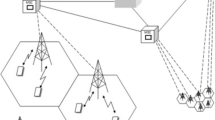Abstract
In this paper, we propose a framework for performing allocation, assignment and admission control (AAA) in next generation cellular networks. A novel heuristic method for resource allocation is proposed. The allocation is done in a semi-distributed manner consisting of central allocation and local allocation. The role of the assignment module is to estimate the amount of resources needed by a user in order to satisfy the quality of service (QoS) requirements of the application. To that end, a Markov based approach which calculates the dropping probability of packets by considering the effects of queuing in the medium access control layer and the adaptive modulation and coding in the physical layer is presented. In order to estimate the required resources, the predicted throughput and delay are calculated based on the dropping probability and the predicted values are mapped to the required ones. The admission control module is responsible for admitting or rejecting a new or handoff user and is based on a mean resource calculation. The calculation takes into account the mean number of resources used by existing users as well as the buffer conditions of the individual users. By combining the three novel contributions on AAA into the AAA framework the overall network as well as the cell-edge throughput have been improved and the number of admitted users have been increased while still guaranteeing QoS for new users as well as existing users.








Similar content being viewed by others
Abbreviations
- AAA:
-
Allocation assignment and admission control
- AC:
-
Admission control
- AMC:
-
Adaptive modulation and coding
- BER:
-
Bit error rate
- BS:
-
Base station
- BW:
-
Bandwidth
- FFR:
-
Fixed frequency reuse
- FSU:
-
Flexible spectrum usage
- Hz:
-
Hertz
- ICI:
-
Inter carrier interference
- KBps:
-
Kilo byte per second
- kbps:
-
Kilo bits per second
- LTE:
-
Long term evolution
- MAC:
-
Medium access control
- mbps:
-
Mega bit per second
- ms:
-
Millisecond
- OFDMA:
-
Orthogonal frequency-division multiple access
- PBS:
-
Priority based scheduler
- PER:
-
Packet error rate
- PHY:
-
Physical layer
- PRB:
-
Physical resource block
- PLR:
-
Packet loss rate
- QAM:
-
Quadrature amplitude modulation
- QoS:
-
Quality of service
- RAN:
-
Radio access network
- RAT:
-
Radio access technology
- RRM:
-
Radio resource management
- SFR:
-
Soft frequency reuse
- SNR:
-
Signal-to-noise ratio
- SINR:
-
Signal to interference plus noise ratio
References
Ramkumar, M. V., Anggorati, B., Stefan, A. L., Prasad, N. R., & Prasad, R. (2010). QoS-guaranteed admission control for OFDMA-based systems. Globecom, pp. 606–610. doi:10.1109/GLOCOMW.2010.5700392.
FP7 ICT Project FUTON, at http://www.ict-futon.eu.
Elayoubi, S. E., Ben Haddada, O., & Fourestie, B. (2008). Performance evaluation of frequency planning schemes in OFDMA-based networks. IEEE Transactions on Wireless Communications, 7(5), 1623–1633. doi:10.1109/TWC.2008.060458.
Li, G., & Liu, H. (2006). Downlink radio resource allocation for multi-cell OFDMA system. IEEE Transactions on Wireless Communications, 5(12), 3451–3459. doi:10.1109/TWC.2006.256968.
Koutsimanis, C., & Fodor, G. (2009). Dynamic resource allocation scheme for guaranteed bit rate services in OFDMA networks. International Conference of Communication Workshops ICC, pp. 2524–2530. doi:10.1109/ICC.2008.478.
Kumar, S., Wang, Y., Marchetti, N., Kovacs, I. Z., Pedersen, K. I., Mogensen, P. E. (2008). Spectrum load balancing for flexible spectrum usage in local area deployment scenario. 3rd IEEE Symposium on New Frontiers in Dynamic Spectrum Access Networks DySPAN, pp. 1–5. doi:10.1109/DYSPAN.2008.93.
Katzela, I., & Naghshineh, M. (1996). Channel assignment schemes for cellular mobile telecommunication systems: A comprehensive survey. IEEE Personal Communications, 3(3), 10–31. doi:10.1109/98.511762.
E3 project deliverable.
Mao, X., Maaref, A., & Teo, K. H. (2008). Adaptive soft frequency reuse for inter-cell interference coordination in SC-FDMA based 3GPP LTE uplinks. Globecom,, pp. 1–6. doi:10.1109/GLOCOM.2008.ECP.916.
R1-050507. (2005). “Soft frequency Reuse scheme for UTRAN LTE”; Huawei, 3g pp TSG RAN WG1 Meeting 41. Athens: Greece.
Krasniqi, B., Wrulich, M., & Mecklenbrauker, C. F. (2009). Network-load dependent partial frequency reuse for LTE. International Symposium on Commnucations and Information Technology ISCIT, pp. 672–676. doi:10.1109/ISCIT.2009.5341160.
Liu, Qingwen, & Wang, Xin. (2006). A cross-layer scheduling algorithm with QoS support in wireless networks. IEEE Transactions on Vehicular Technology, 55(3), 839–847. doi:10.1109/TVT.2006.873832.
IEEE 1900.4. Architectural building blocks enabling network-device distributed decision making for optimized radio resource usage in heterogeneous wireless access networks.
Zhang, Q., & Kassam, S. (1999). Finite-state Markov model for Rayleigh fading channels. IEEE Transactions on Communications, 47(11), 1688–1692. doi:10.1109/26.803503.
Liu, Qingwen, & Zhou, Shengli. (2005). Cross-layer scheduling with prescribed QoS guarantees in adaptive wireless networks. IEEE Journal on Selected Areas, 23(5), 1056–1066. doi:10.1109/JSAC.2005.845430.
Liu, Qingwen, Zhou, Shengli, & Giannakis, Georgios B. (2005). Queuing with adaptive modulation and coding over wireless links: Cross-layer analysis and design. IEEE Transaction on Wireless Communications, 4(3), 1142–1153.
Cooper, R. B. (1981). Introduction to Queuing Theory (2nd ed.). North-Holland: Elsevier.
IST-4-027756 WINNER II. (2007). D1.1.2, WINNER II Channel Models part I.
Acknowledgments
The authors would like to thank “Fibre-Optic Networks for Distributed Extendible Heterogeneous Radio Architectures and Service Provisioning (FUTON)”—an EU funded FP7 project (ICT-2007-215533) and “Research and Development on Converged network of wireless and wired systems using frequency sharing type wireless technologies”—a research project funded by NICT, Japan.
Author information
Authors and Affiliations
Corresponding author
Rights and permissions
About this article
Cite this article
Ramkumar, M.V., Nielsen, R.H., Stefan, A.L. et al. A Joint Allocation, Assignment and Admission Control (AAA) Framework for Next Generation Networks. Wireless Pers Commun 73, 1245–1267 (2013). https://doi.org/10.1007/s11277-013-1276-8
Published:
Issue Date:
DOI: https://doi.org/10.1007/s11277-013-1276-8



